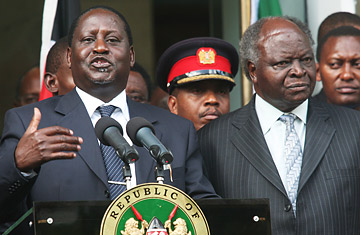
Raila Odinga, left, and Mwai Kibaki
Kenya's warring political factions finally agreed to the details of a power-sharing government on Sunday, after weeks of delay that had drawn the fury of foreign diplomats and regular Kenyans who had begun to doubt their leaders' commitment to resolving a political crisis that killed some 1,200 people. Said President Mwai Kibaki after the horse-trading was finalized: "Let us build a new Kenya where justice is our shield and defender and where peace and liberty and plenty will be found throughout the country."
For many Kenyans and outside observers, however, those kinds of pledges will ring false. For one, the reconciliation process was tortured to say the least, dragging on for more than a month after former U.N. Secretary General Kofi Annan brokered a power-sharing deal, because the two sides bickered over who should get which powerful Cabinet posts. What's more, in hammering out compromises, the rivals have simply expanded the size of the government — increasing its costs — in order to reward their followers.
As expected, President Mwai Kibaki named opposition leader Raila Odinga to the new post of Prime Minister. More dramatically, Kibaki and Odinga — who accused the President of rigging a December 27 election — managed to agree on how to parcel out posts in a new Cabinet equally among their allies. While Kibaki's team retained most of the powerful posts, including finance and foreign affairs, Odinga's allies in the Orange Democratic Movement got several choice spots as well. Musalia Mudavadi, Odinga's No. 2, was named deputy prime minister, as was a prominent Kibaki ally, Uhuru Kenyatta, son of independent Kenya's first President, Jomo Kenyatta.
However, in the end, when they could not entirely agree, Kibaki and Odinga decided to create more ministries, expanding the number from 34 to 42. Some seemed questionable, There is not only a ministry for development, but now a ministry for Northern Kenya and other Arid Lands. Nairobi, which already has its own city government, will get a new federal ministry, too. The country will also get a ministry for "Planning and Vision 2030," whose tasks are so far undefined.
For Kenya, a country where corruption is rife and ministers use their power chiefly as a means of enriching themselves, it was no surprise to many civil society groups that leaders would see Cabinet ministries not as platforms from which to govern effectively, but as prizes to be handed out to loyal followers. "If you look at the opposition and government, these are people who a few years ago were saying, 'We need a lean Cabinet, we need to rein in government expenditures,'" said Stephen Lugalia, chairman of the Institute of Certified Public Accountants of Kenya. "These are very knowledgeable people. They have decided to ignore that and said, 'We're just going to make sure we'll take care of our people.'"
Economists such as Lugalia questioned the wisdom of taking on the burden of new government ministries — with their attendant offices, staff, bodyguards and state-issued luxury cars — at a time when the Kenyan economy is slowing down and hundreds of thousands of displaced people still need help. The Institute of Certified Public Accountants has said the country will not be able to afford the financial burden of several new ministries, which it estimated would each cost 8.8 billion shillings (about $140 million) per year.
The decision to expand the Cabinet was seen as particularly galling because at least half of Kenya's people live on less than a dollar a day. The government has requested 30 billion shillings (nearly $500 million) to help resettle displaced people, and last week, the government appealed for another 7 billion shillings ($113 million) to fight malaria. It has also announced that supplies of HIV/AIDS drugs are running low.
In any case, the expensive new Cabinet must get to work quickly to heal a country shattered after the December 27 vote. The ministers who join the new government will face daunting tasks. Economic growth is expected to be as low as 4% this year, down from nearly 7% last year. The 300,000 displaced have not returned to their homes, and resentments over ethnicity, land and resources still linger. Tension in the slums remains high. Kenya's population has exploded to more than 40 million, and the country is quickly running out of enough land for all its people.
In spite of the hoopla over the formation of the new government, many observers remain skeptical about its prospects. A senior Western diplomat in Nairobi was blunt: "Kenyans welcomed the apparent agreement, though their media ridiculed the prospect of a Cabinet of 40 thieves. We're still keen to work with a genuine power-sharing government, but we'll watch closely how efficiently and transparently it uses resources." Kenyans will be watching whether or not Odinga and Kibaki will actually share power. They remember 2005, when Kibaki dismissed many members of his Cabinet — including Odinga — because it was riven by internal strife. The political deal has brought many of those same faces back to power. "What we are seeing is not a new situation," says Barasa Tiberius, a senior analyst at the Institute of Policy Analysis and Research. "We are seeing history repeating itself. How can they stick together now if they differed on the way forward last time?"
